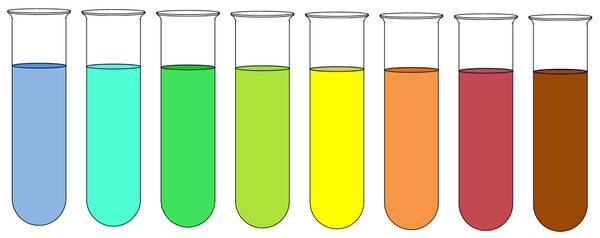Glucose
Contents
Key Stage 3
Meaning
Glucose is a simple sugar with formula C6H12O6.
About Glucose
- Glucose has a store of chemical potential energy.
- Glucose is used in respiration to provide energy for cells.
- Glucose can be detected using the Benedict's Test.
Testing For Glucose
- Glucose can be detected with the Benedict's Test.
Method
- 1. A sample of food is dissolved in water.
- 2. The solution is added to blue Benedict's solution in a boiling tube.
- 3. The solution is kept at 90°C for up to 10 minutes.
- 4. A colour change indicates the presence of glucose or fructose. If they are present the solution will eventually turn brick red or brown.
| When sugar is present the Benedict's solution turns from blue through several colours until it becomes brick red or brown.
If this was done with sucrose the Benedict's solution would stay blue. |
Key Stage 4
Meaning
Glucose is a monosaccharide which all have the formula C6H12O6.
About Glucose
- Glucose has a store of chemical potential energy.
- Glucose is used in respiration to provide energy for cells.
- Two glucose molecules bonded together make maltose.
- Many glucose molecules bonded together make starch.
- Glucose can be detected using the Benedict's Test.
Testing For Glucose
- Glucose, and other monosaccharides, can be detected with the Benedict's Test.
Method
- 1. A sample of food is dissolved in water.
- 2. The solution is added to blue Benedict's solution in a boiling tube.
- 3. The solution is kept at 90°C for up to 10 minutes.
- 4. A colour change indicates the presence of glucose or fructose. If they are present the solution will eventually turn brick red or brown.
| When sugar is present the Benedict's solution turns from blue through several colours until it becomes brick red or brown.
If this was done with sucrose the Benedict's solution would stay blue. |
References
AQA
- Glucose, page 172, GCSE Chemistry; Third Edition, Oxford University Press, AQA
- Glucose, pages 111, 115, 120, 122, 126, GCSE Biology, Hodder, AQA
- Glucose, pages 184, 185, GCSE Combined Science Trilogy; Biology, CGP, AQA
- Glucose, pages 20-21, 124, 128-129, 134-136, 138-139, 162-165, GCSE Biology; Third Edition, Oxford University Press, AQA
- Glucose, pages 210, 211, GCSE Biology, CGP, AQA
- Glucose, pages 242-3, 252, 295, 298, 300, GCSE Chemistry; Student Book, Collins, AQA
- Glucose, pages 36-7, 55, 56, 58, 69, 93, 103, 116, 170, 192, 215, 228, GCSE Biology; Student Book, Collins, AQA
Edexcel
- Glucose, page 118, GCSE Combined Science, Pearson Edexcel
- Glucose, page 170, GCSE Biology, Pearson, Edexcel
- Glucose, pages 198, 199, 238-241, 270, 271, GCSE Biology, CGP, Edexcel
- Glucose, pages 69, 81, 92, GCSE Biology; The Revision Guide, CGP, Edexcel
- Glucose; control of blood levels, pages 106-107, GCSE Combined Science, Pearson Edexcel
- Glucose; control of blood levels, pages 150-151, GCSE Biology, Pearson, Edexcel
